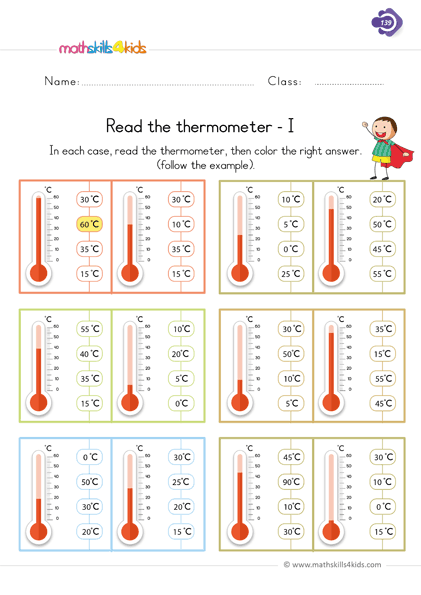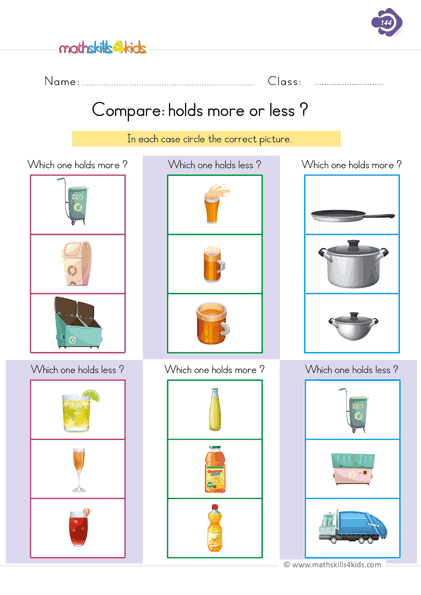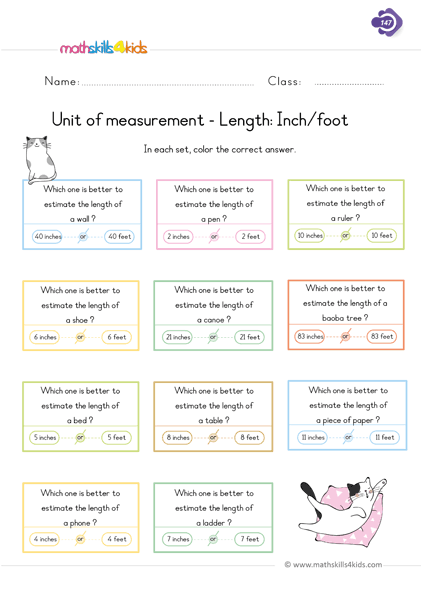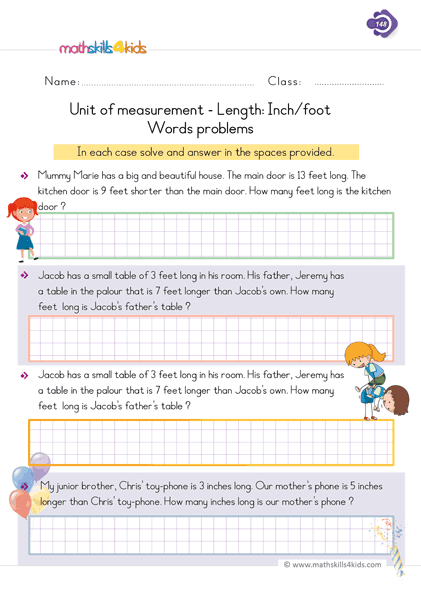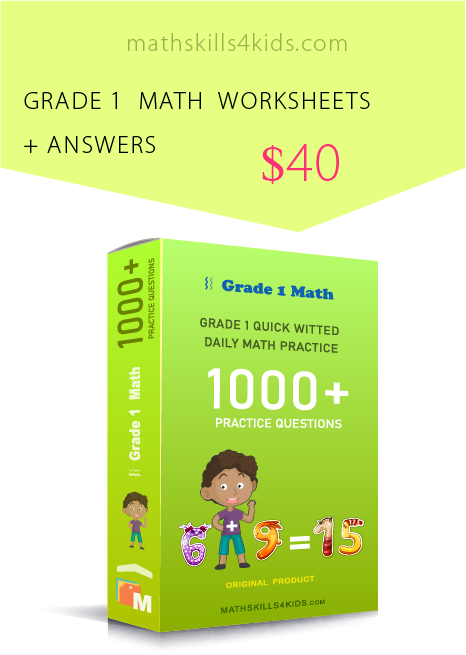Free printable 1st Grade measurement worksheets and activities
-
Are you looking for some fun and easy ways to teach your 1st grader about measurement? Do you want to help them develop their math skills and confidence? If so, you've come to the right place!
Do you know why measurement skills are essential for 1st graders? In this article, we'll share with you a variety of free printable 1st Grade measurement worksheets where you'll learn the importance of measurement skills and how to teach and make measurement fun for kids.
We'll also give you some tips and tricks to make measurement learning easy and enjoyable.
Above all, you'll discover the best way to assess your child's progress and provide feedback. Plus, as a bonus, we'll show you some websites to download free printable measurement flashcards and games.
So let's get started!
Why measurement skills are essential for 1st Graders
Apart from being one of the most essential math topics in first grade, you'll discover several other reasons why measurement skills are essential to 1st graders.
First, measurement skill helps kids understand the world around them and compare different objects and quantities.
Also, measurement helps them develop spatial awareness, logical thinking, problem-solving, and communication skills.
In fact, by learning measurement, 1st graders can answer questions such as:
- How long is this pencil?
- How much does this apple weigh?
- How many cups of water can fit in this jug?
- How tall is this tree?
- How hot or cold is it today?
These questions are not only relevant to math but also to science, art, geography, and everyday life.
-
BROWSE THE WEBSITE
-
DOWNLOAD FREE WORKSHEETS
-
-
1st GRADE MATH TOPICS
- Counting and numbers
- Understand addition
- Addition skills
- Addition exercises
- Addition strategies
- Understand subtraction
- Subtraction skills
- Subtraction Exercises
- Subtraction strategies
- Mixed operation
- Comparing numbers up to 100
- Estimation Worksheets
- Place value
- Spatial sense
- Graphing & data
- Measurement
- Patterns
- Probability
- Sorting & classifying
- Telling time
- 2D shapes
- 3D shapes - Solids figures
- Fractions
-
-
How to teach measurement concepts using fun and engaging activities
The best way to teach measurement concepts to 1st graders is to use fun and engaging activities that involve hands-on exploration and discovery.
Here are some examples of activities that you can do with your child at home or in the classroom:
- Use a ruler, a tape measure, or a string to measure the length of different objects in your house or classroom.
Use non-standard units such as paper clips, crayons, or Lego bricks. Compare the lengths of different objects and arrange them from shortest to longest or vice versa.
- Use a scale or a balance to measure the weight of different objects in your kitchen or pantry. Use non-standard units such as coins, marbles, or spoons.
Compare the weights of different objects and arrange them from lightest to heaviest or vice versa.
- Use a measuring cup or a jug to measure the capacity of different containers in your bathroom or laundry room.
You can also use non-standard units such as cups, bottles, or cans. Compare the capacities of different containers and arrange them from smallest to largest or vice versa.
- Use a thermometer or a weather app to measure the temperature of different places in your house or neighborhood.
You can also use non-standard units such as ice cubes, warm water, or hot chocolate. Compare the temperatures of different places and arrange them from coldest to hottest or vice versa.
- Use a ruler, a tape measure, or a string to measure the length of different objects in your house or classroom.
-
A variety of free printable worksheets to practice measurement skills
To help you reinforce the practice of measurement concepts and skills that you teach in your classroom, we have created a variety of free printable worksheets that cover different topics and levels of difficulty.
You can use these worksheets as homework assignments, review exercises, assessment tools, or extra practice for your students.
Here are some of the worksheets that you will find in this set:
Read the Thermometer
This worksheet helps students practice reading the temperature in Celsius and Fahrenheit scales.
They have to look at the thermometers and write the correct temperature for each.
Compare Height: Tall vs. Short
This worksheet helps students practice comparing the height of different objects.
They have to look at the pictures and circle the taller or shorter object in each pair.
Compare: Light vs. Heavy
This worksheet helps students practice comparing the weight of different objects.
They have to look at the pictures and circle the lighter or heavier object in each pair.
Compare: Holds More vs. Holds Less
This worksheet helps students practice comparing the capacity of different containers.
They must look at the pictures and circle the container with more or less liquid in each pair.
Compare: Size, Weight, and Capacity
This worksheet helps students practice comparing three attributes of different objects: size, weight, and capacity.
They have to look at the pictures and circle the object that is bigger or smaller, lighter or heavier, or holds more or less liquid in each pair.
Compare: Wide vs. Narrow
One of the basic skills that students need to learn in measurement is comparing two objects based on their width. In these worksheets, students will look at two pictures and decide which is wider or narrower.
They will then circle or write the correct answer in the blank space. These worksheets are great for developing students' visual discrimination and spatial awareness skills.
Unit of Measurement - Length: Inch and Foot
Another essential skill that students need to learn in measurement is how to use standard units of measurement to measure length. In these worksheets, students will learn about the inch and the foot as units of measurement.
They will also practice measuring different objects using an inch or foot ruler. They will then write the length of each object in inches or feet. These worksheets are perfect for introducing students to the concept of standard units of measurement and how to use them.
Measure using a ruler in centimeters
Besides using standard units of measurement, students also need to learn how to use metric units of measurement to measure length. In these worksheets, students will practice measuring different objects using a centimeter ruler.
They will then write the length of each object in centimeters. These worksheets are ideal for helping students understand the metric system and how to use it.
Metric Unit of Length: Centimeter and Meter
In addition to measuring length using a centimeter ruler, students also need to learn how to convert between different metric units of length, such as centimeters and meters. In these worksheets, students will learn about the relationship between centimeters and meters.
They will also practice converting between these two units of measurement using a conversion chart. They will then solve some word problems involving metric units of length. These worksheets are excellent for enhancing students' problem-solving and reasoning skills.
Metric Unit of Weight: Grams and Kilograms
Another aspect of measurement that students need to learn is how to measure weight using metric units of measurement, such as grams and kilograms. In these worksheets, students will learn about the gram and the kilogram as weight units.
They will also practice weighing different objects using a balance or digital scale. They will then write the weight of each object in grams or kilograms. These worksheets are excellent for exposing students to the concept of weight and how to measure it.
-
Tips and tricks to make measurement learning easy and enjoyable
Here are some tips and tricks that you can use to make measurement learning easy and enjoyable for your child:
- Use everyday objects your child is familiar with and interested in to measure. For example, you can use their toys, books, clothes, shoes, etc.
- Use colorful and attractive materials to measure. For example, you can use stickers, pom poms, beads, etc.
- Use games and songs to make measurement fun. For example, you can play "I Spy" with measurement words (e.g., I spy something long), sing "The Ruler Song" (e.g., A ruler is a tool that we use to measure length), etc.
- Use praise and encouragement to motivate your child. For example, you can say, "Wow! You measured that very well!" "You're doing a great job!" "You're a measurement master!"
- Use feedback and correction to help your child improve. For example, you can say, "Oops! You forgot to line up the zero on the ruler." "That's close, but not quite. Try again." "You're almost there. Just one more step."
-
How to assess your child's progress and provide feedback
To assess your child's progress and provide feedback, you can use some of the following methods:
- Use the worksheets we provided to check your child's understanding and skills. You can also use the included answer keys to mark their work and give them feedback.
- Use informal observations and questions to monitor your child's learning. For example, you can watch how they measure different objects and ask them questions such as "How did you measure that?" "Why did you choose that unit?" "How can you check your answer?"
- Use quizzes and tests to measure your child's achievement and growth. You can also use the included rubrics and scoring guides to grade their work and give them feedback.
Bonus: Free printable measurement flashcards and games
As a bonus, we've also prepared some free printable measurement flashcards and games that you can use to review and practice measurement skills with your child.
These flashcards and games cover various measurement topics such as length, weight, capacity, temperature, time, money, etc.
They also include questions such as matching, sorting, ordering, estimating, comparing, converting, and word problems.
You can use the links below and access free printable measurement flashcards and games.
-https://www.liveworksheets.com/worksheets/en/Math/Units_of_measurement
-https://sacredheartschool-gorton.org.uk/wp-content/uploads/2020/03/Sorting-Comparing.pdf
-https://www.splashlearn.com/math/measurement-games-for-1st-graders
Thank you for sharing the links of MathSkills4Kids.com with your loved ones. Your choice is greatly appreciated.
We hope you enjoyed this resource and found it helpful in teaching your 1st grader about measurement.
Happy measuring!
-
